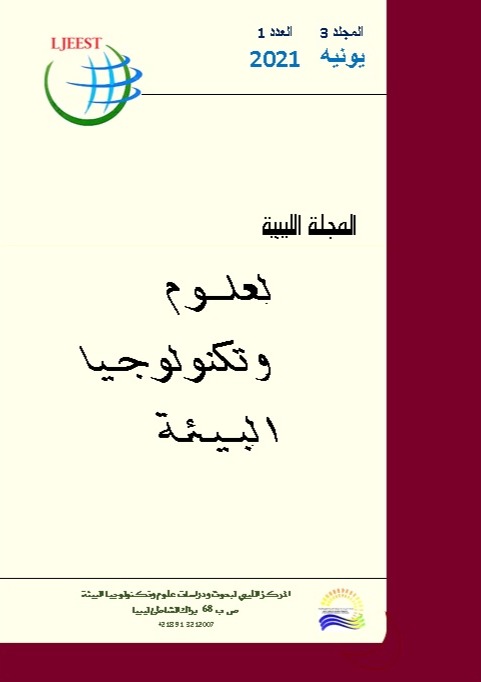تشكل العقيدات لمختلف البقوليات العشبية الليبية
DOI:
https://doi.org/10.63359/get3w403الكلمات المفتاحية:
جذور النبات، تكوُّن العقد، تثبيت النيتروجين، العائلة البقوليةالملخص
عند دراسة تشكل وأنماط العقد المتكونة أمكن ملاحظة الشكل المروحي للعقدة عند إرتباط البكتريا Rhizobium meliloti مع النبات البقولي M. polymorpha ، وعقدة بشكل أصابع اليد في حالة النبات M. minima ونتشأ على الجذور الجانبية، بينما لوحظ الشكل المستدير للعقدة في حالة إرتباط البكتريا Rhizobium. trifolii مع النبات البقولي O. viscosa وتتصل بالجذر الوتدي مباشرة. إتضح أن أكبر عدد للعقد الجذرية في النبات O. viscosa بمتوسط 19 عقدة/للجذر ، وأقل عدد للعقد المتكونة في النبات M. polymorpha بمتوسط 4.43 عقدة/ للجذر، كما وجد أن أطول عقدة في النبات M. minima بمتوسط 2.99 سم ، وأقصر عقدة في النبات M. polymorpha بمتوسط 1.59 سم. وقد تباينت أشكال البكتيرويد حسب نوع البكتريا داخل خلايا العقدة. ولقياس نشاط العقد تباينت ألوان مقاطعها من الأسود الداكن إلى البني الفاتح إلى الوردي. أثبتت هذه الدراسة وجود نوعين من العقد غير محددة النمو في نباتي M. polymorpha و M. minima وكلاهما كانت متطاولة الشكل ولهما نسيج مرستيمي قمي وتحتويان على عديد من الأنسجة المركزية ، ومحددة النمو في نبات O. viscosa والتي تفتقر للمرستيم النشط فتظهر العقدة مستديرة تحتوي على منطقة مركزية متجانسة ذات نسيج واحد يقوم بعملية تثبيت النيتروجين.
المراجع
Alexander, M. (1982). Soil Microbiology, 2nd ed. John Wiley & Sons, INC. New York, , Pp 573
Ali, R. F. M., Ensaf, H. D., and Fatma, M. W. (2019). Analysis and diversity of family Fabaceae in Flora of Libya. Libyan Journal of Science & Technology 10 (1): 13-19.
Bonaldi, K., Gargani, D., Prin, Y., Fardoux, J., Gully, D., Nouwen, N., Goormachtig, S., and Giraud, E. (2011). Nodulation of Aeschynomene afraspera and A. indica by photosynthetic Bradyrhizobium Sp. Strain ORS285: The Nod-dependent versus the Nod-independent symbiotic interaction. Molecular Plant-Microbe Interactions 24(11): 1359-1371.
Czernic, P., Gully, D., Cartieaux, F., Moulin, L., Guefrachi, I., Patrel, D., Pierre, O., Fardoux, J., Chaintreuil, C., Nguyen, P., Gressent, F., Da Silva, C., Poulain, J., Wincker, P., Rofidal, V., Hem, S., Barriere, Q., Arrighi, J.F., Mergaert, P., and Giraud, E. (2015). Convergent evolution of endosymbiont differentiation in dalbergioid and Inverted Repeat-Lacking Clade legumes mediated by Nodule-Specific Cysteine-Rich peptides. Plant Physiology 169(2): 1254-1265.
Dilworth, M. J., Euan K. J., Janet I. S., and William E. N. (2008). Nitrogen-fixing Leguminous Symbioses. Published by Springer, P.O. Box 17, 3300 AA Dordrecht, The Netherlands. 402 Pp
Giller, K. E. (2001). Nitrogen fixation in tropical cropping systems. doi: 10.1079/9780851994178.0000
Gomez K., and Gomez, A. (1984). Statistical procedures for agricultural research. John Wiley and Sons, New York, USA, 680pp.
Gopalakrishnan S., DasGupta M., Rajeev K. and Manish K. P. (2020). Molecular Basis of Root Nodule Symbiosis between Bradyrhizobium and ‘Crack-Entry’ Legume Groundnut (Arachis hypogaea L.). Plants, 9, 276
Hadri, A. E., Spaink, H. P., Bisseling, T. and Brewin, N. J. (1998). Diversity of root nodulation and rhizobial infection processes. In The Rhizobiaceae: Molecular Biology of Model Plant Associated Bacteria (ed. H. P. Spaink, A. Kondorosi, and P. Hooykaas,), pp. 347-360. The Netherlands: Springer.
Izadpanah, M., and Jafari A. A. (2012). Evaluation of Seeds and Pods Variation of 5 Annual Medic Medicago Spp. Journal of Rangeland Science, (3)1:71-82.
Jafri, S. and El-Gadi, A. (1980). Flora of Libya (Fabaceae). Bot. Department, Faculty of Sci., Tripoli Univ., Libya.
Jafri, S. and El-Gadi, A. (1980). Flora of Libya (Fabaceae). Bot. Department, Faculty of Sci., Tripoli Univ., Libya.
Khalefah, M. O. A. (2013). Phenotypic diversity of rhizobia nodulating some wild leguminous plants growing in Libya. Ms.C. Thesis. Faculty of Science - Sebha University. (in Arabic)
Lerouge, P., Roche, P., Faucher, C., Maillet, F., Truchet, G., Promé, J. C. and Dénarié, J. (1990). Symbiotic host-specificity of Rhizobium meliloti is determined by a sulphated and acylated glucosamine oligosaccharide signal. Nature 344, 781-784.
Loi, A., Porqueddu C., Veronesi F., and Cocks P. S. (1995). Distribution, diversity and potential agronomic value of Medicago polymorpha in Sardinia. J. Agric. Sci. Camb. 124:419-426.
Lotocka, B., Kopcińska J. and Skalniak M. (2012). The meristem in indeterminate root nodules of Faboideae. Review article. Symbiosis 58:63–72.
Mohamed, S. H., Khalifa M. O. A. and Babiker N. N. (2018). Physiological and symbiotic characteristics of Rhizobia isolated from Medicago polymorpha L and Trigonella stellate L growing in semi-arid regions of Libya. Advances in Bioscience and Bioengineering. 6(4): 34-41
NCSS 2020 Statistical Software (2020). NCSS, LLC. Kaysville, Utah, USA, ncss.com/software/ncss.
Olwey, A. O. M. K. (2019). Taxonomic studies on the family Leguminosae in Egypt. Ph.D. Thesis, Faculty of Science, Assiut University.
Oono, R., Schmitt, I., Sprent, J.I., and Denison, R.F. (2010). Multiple evolutionary origins of legume traits leading to extreme rhizobial differentiation. New Phytologist 187(2): 508-520.
Pommeresche, R., and Hansen S. (2017). Examining root nodule activity on legumes. FertilCrop Technical Note. Download at www.fertilcrop.net
Ren, G. (2018). The evolution of determinate and indeterminate nodules within the Papilionoideae subfamily, PhD thesis, Wageningen University, Wageningen, the Netherlands 130 Pp.
Sharma, V., Bhattacharyya S., Kumar R., Kumar A., Ibañez F., Wang J., Guo B., Hari K., Somasegaran, P., and Hoben, H. J. (1985). Methods in legume‐rhizobium technology. NifTAL Project and MIRCEN. Department of Agronomy, 2nd Soil Science Hawaii Institute Tropical Agriculture Human Research, University of Hawaii at Manoa, Honolulu.
Stevens, P. (2008). Angiosperm Phylogeny Website, Version 9, June 2008. www.mobot.org/MOBOT/research/APweb.
Turini, F.G., Bräuchler, C. and Heubl, G. (2010). Phylogenetic relationships and evolution of morphological characters in Ononis L.(Fabaceae). Taxon 59: 1077–1090.
Willkomm, M. (1877). Papilionaceae. In: Willkomm, H.L. and Lange, J. (eds.) Prodromus Florae Hispanicae. E. Schweizerbart, Stuttgart, Pp. 247–470.
Woomer, P.L., Karanja, N., Kisamuli, S.M., Murwira, M., and Bala, A. (2011). A revised manual for rhizobium methods and standard protocols available on the project website, www.N2Africa.org, 69 pp. www.springer.com















